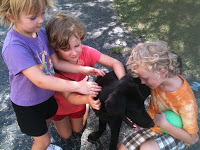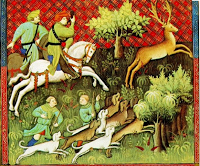Medieval History
 And so, after months of earnest discussion, and weeks of serious house rearranging, we have brought Sawyer home. He is a one-year-old black lab with a little something else thrown in, and is gentle and attentive and beautiful and curious and really, really nice. We somehow managed to keep it a secret from the kids (they had basically given up on us ever coming through), and so the homecoming was all theirs. There was standing aghast and running and looking at us and a lot a lot of talking. We've had friends over to meet Sawyer and provide wise counsel (Mac grew up with dogs, me, not at all) and the neighborhood itself looks different (other dogs come over to say hello while on their walks) than it did before. Eleanor declared this the best day ever (and this part of it may well be), Oliver was full of questions ("How does a dog feel love?" "Do you just recognize someone by their smell, or do you really get to know them, know who they are by their smell?"). Iris said nothing for a long, long time - too busy hugging her dog and walking with him here and there. But at the end of the day, I did ask her: "What do you think of it all?" and she replied "It's just incredible that it's for keeps."
And so, after months of earnest discussion, and weeks of serious house rearranging, we have brought Sawyer home. He is a one-year-old black lab with a little something else thrown in, and is gentle and attentive and beautiful and curious and really, really nice. We somehow managed to keep it a secret from the kids (they had basically given up on us ever coming through), and so the homecoming was all theirs. There was standing aghast and running and looking at us and a lot a lot of talking. We've had friends over to meet Sawyer and provide wise counsel (Mac grew up with dogs, me, not at all) and the neighborhood itself looks different (other dogs come over to say hello while on their walks) than it did before. Eleanor declared this the best day ever (and this part of it may well be), Oliver was full of questions ("How does a dog feel love?" "Do you just recognize someone by their smell, or do you really get to know them, know who they are by their smell?"). Iris said nothing for a long, long time - too busy hugging her dog and walking with him here and there. But at the end of the day, I did ask her: "What do you think of it all?" and she replied "It's just incredible that it's for keeps."
Do animals have a history? Can one speak of a medieval dog the way one does of a medieval person, as a being with different conceptions of self and world? Nature (ask Thoreau and the other Transcendentalists) can be understood as the ultimate transcendental entity - it may change in form, but not in essence. Humanity, on the other hand, has cultivated and ritualized even its most "natural" behaviors (sex, childbirth, death have produced cultures and subjectivities whose essential differences are the historian's fervent work). Where does a dog, so closely tied to humans, so closely attuned to nature, exist on the continuum between nature and humanity? Would the same things matter to a medieval dog as to a modern dog? Is the human-hound relationship transcendent? Is Yolande de Soisson's lap dog represented as attentive to the statue (or vision) of the Madonna and Child because its mistress's concern for salvation has become its own somehow? Or is the artist using the dog to point out that "even animals" respond to the presence of the divine?
Would I be better off asking questions of survival rather than symbolism? Looking to the mutual benefit of the human-hound relationship in something like hunting? But looking at Sawyer tonight, and watching him keeping track of the kids, feeling glad when he decided to settle at my feet, I have to think beyond pragmatism, to the complexity of emotion that accompanies a hunt, or that presides over the company after a victory (J. Salisbury, in The Beast Within; Animals in the Middle Ages present examples of ritualized feeding of certain cuts of meat to the hounds after a hunt).
What, then, of Mary of Burgundy's dog, curled up in her lap while she reads her Book of Hours? Does its comfortable inattention to the divine signal a distinction between her secular world and the sacred space framing the Madonna outside her window? Or is it her own, a comfort to her? I don't know the answers to any of these questions, and I wonder how you'd research them. The one I return to is, Would the same things matter to a medieval dog as to a modern dog? These images of intimacy and comfort would venture to say yes, even as the selfhood and worldview of a young woman today are essentially different entities. Or is it that animals awaken the transcendental in us: have young girls throughout all history looked up and marveled "for keeps"?
- Briefly Noted -- Accessus: A Journal Of Premodern Literature And New Media
Readers of Modern Medieval will want to go take a look at the inaugural issue of Accessus, a publication of the Gower Project. This excellent-looking first issue includes the following essays that bring together disability studies, medieval studies, manuscript...
- Thorough Thoreau
I would be willing to bet that Thoreau did not have children when taking his walks, especially six year olds who do not suffer pebbles in their shoes gladly. The fall colors are here, quite suddenly it seems, and so we take to the woods. But...
- Cfp: Eco-critical Approaches To Medieval Art
Fontaine Ste.-Barbe (Le Faouët, Brittany)Eco-Critical Approaches to Medieval Art: East and West ICMA (International Center of Medieval Art) Panel at the 48th International Congress on Medieval Studies May 9-12, 2013 at Western Michigan University, Kalamazoo,...
- Very Sad
A.-F. Desportes, Dog and Pheasant, 1780sThis painting has always reminded me of Sawyer: change the coat to black and elongate the tail, and there's our hound.Was. I'm so sad to write that we've decided to find another home for Sawyer. ...
- Fabyowlis
That, you see, is how "fabulous" is spelled when you're Miss I writing about your week-end. And indeed the adventures these chickitas managed to have bespeaks some serious fabyowlosity. How long, do you think, before Miss E joins a punk band? ...
Medieval History
For Keeps
 |
| Yolande de Soisson |
 |
| Gaston Phoebus |
 |
| Mary of Burgundy |
- Briefly Noted -- Accessus: A Journal Of Premodern Literature And New Media
Readers of Modern Medieval will want to go take a look at the inaugural issue of Accessus, a publication of the Gower Project. This excellent-looking first issue includes the following essays that bring together disability studies, medieval studies, manuscript...
- Thorough Thoreau
I would be willing to bet that Thoreau did not have children when taking his walks, especially six year olds who do not suffer pebbles in their shoes gladly. The fall colors are here, quite suddenly it seems, and so we take to the woods. But...
- Cfp: Eco-critical Approaches To Medieval Art
Fontaine Ste.-Barbe (Le Faouët, Brittany)Eco-Critical Approaches to Medieval Art: East and West ICMA (International Center of Medieval Art) Panel at the 48th International Congress on Medieval Studies May 9-12, 2013 at Western Michigan University, Kalamazoo,...
- Very Sad
A.-F. Desportes, Dog and Pheasant, 1780sThis painting has always reminded me of Sawyer: change the coat to black and elongate the tail, and there's our hound.Was. I'm so sad to write that we've decided to find another home for Sawyer. ...
- Fabyowlis
That, you see, is how "fabulous" is spelled when you're Miss I writing about your week-end. And indeed the adventures these chickitas managed to have bespeaks some serious fabyowlosity. How long, do you think, before Miss E joins a punk band? ...
